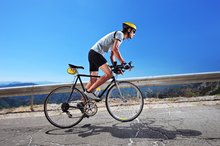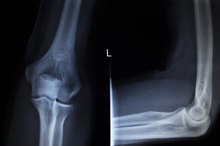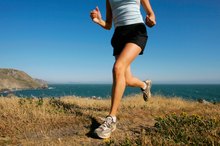Testicle Damage From Cycling
Riding a bicycle increases muscle strength and promotes fitness. However, if not done properly, cycling can harm you. One of the most common locations for discomfort and injury on a bicycle is the testicles. Testicle damage from cycling is usually caused by a seat that does not fit properly.
If you are experiencing serious medical symptoms, seek emergency treatment immediately.
Anatomy
A bicycle seat is shaped with a wide back and a narrow front, often called the nose. As you sit on a bicycle seat, the nose can place pressure on the testicles and the surrounding area. Over time, this pressure can cause damage to the testicles and the surrounding area. However, in most cases chronic pain will occur before damage takes place, warning you to change the way you sit on your bicycle.
- A bicycle seat is shaped with a wide back and a narrow front, often called the nose.
- As you sit on a bicycle seat, the nose can place pressure on the testicles and the surrounding area.
Neuropathy
Bicycle Seat & Nerve Damage
Learn More
Neuropathy refers to any nerve damage in the body. The pudendal nerve is between your genitals and your anus and is responsible for sending information, including pain signals, to the testicles and surrounding area. If your bicycle seat places pressure on the pudendal nerve, it can cause pain in the testicles and warn you of possible testicular damage. Pain from neuropathy is particularly noticeable when sitting and can also present with general numbness in the genital area.
- Neuropathy refers to any nerve damage in the body.
- The pudendal nerve is between your genitals and your anus and is responsible for sending information, including pain signals, to the testicles and surrounding area.
Prevention
The best way to prevent testicle damage from cycling is to choose a bike seat that fits properly. The wide back of your bike seat is meant to contact directly with your ischial tuberosities, which are the hard bones you feel when you sit down. If your seat is too narrow, your ishial tuberosities will slip over the outside edges, pressing the middle of your seat and the nose into your pudendal nerve and testicles. A properly fitted seat will release pressure from both of these areas. You might also consider bicycle seats with shortened nose areas or those designed with grooves down the middle of the seat that reduce pudendal nerve pressure 2.
- The best way to prevent testicle damage from cycling is to choose a bike seat that fits properly.
- The wide back of your bike seat is meant to contact directly with your ischial tuberosities, which are the hard bones you feel when you sit down.
Treatment
Cycling With Pinched Nerves
Learn More
Treatment for testicle damage from cycling should start with rest and ice to reduce the swelling. Continuing to ride your bike will only make the problem worse. Avoid sitting on hard surfaces or positions with seem to make the pain or numbness worse. If your pain does not go away after a few days, make an appointment with your doctor to discuss possible neuropathy or testicular trauma caused by riding your bicycle.
- Treatment for testicle damage from cycling should start with rest and ice to reduce the swelling.
- Avoid sitting on hard surfaces or positions with seem to make the pain or numbness worse.
Related Articles
References
- Health Communities; Testicular Pain Causes; Stanley J. Swierzewski III; May 2007
- Jim Langley: Bicycle Seats Explained
- Sheldon Brown: A Comfortable Saddle
- Durante JA, Macintyre IG. Pudendal nerve entrapment in an Ironman athlete: a case report. J Can Chiropr Assoc. 2010;54(4):276–281.
- Kaur J, Singh P. Pudendal nerve entrapment syndrome. StatPearls. Updated June 21, 2019.
- Durante JA, Macintyre IG. Pudendal nerve entrapment in an Ironman athlete: a case report. J Can Chiropr Assoc. 2010;54(4):276–281.
- Antolak Jr SJ Pudendal Neuralgia: Pudendal Nerve Entrapment, Alcock Canal Syndrome, and Pudendal Canal Syndrome. Genitourinary Pain And Inflammation. Ed: Jeannette M. Potts. Humana Press, Totowa, NJ. 2008. pp 39-56.
Writer Bio
Patrick Hutchison has been doing freelance work since 2008. He has worked as a physical therapy aide and as a writer for various websites including Destination Guides and several travel-related companies. Hutchison has a Bachelor of Arts in history and anthropology from the University of Washington.









